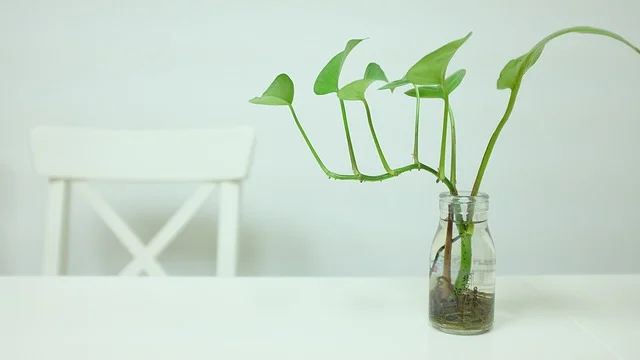Growing Pothos in water can be great! Here’s our guide on how to do it
You can see all the roots, which can be pretty cool. Water can be just as good as soil. And Pothos is unlikely to get root rot.
To grow Pothos in water, you will need a glass vase, clean water, and liquid fertilizer.
Once a small cutting has developed roots, move it into the display vase, and make sure to replace the water, clean the algae, and give it more fertilizer when you need to.
Keep it at a consistent temperature, and keep it well away from drafts, air-cons, or heating units.
Table of Contents
Why grow Pothos in water
It looks cool
One of the first reasons you want to grow your Pothos in water is quite simply because it looks cool. And I know, this might seem like a bit of a surface level reason, but surely aesthetics is one of the main reasons that people have houseplants in the first place?
Rather than just seeing the leaves of the plant, with the Pothos, you can see the entire structure, including the roots that keep it alive and upright.
It’s something that you can do with them that you can’t do with most other houseplants. Try this with a snake plant, and you won’t have much luck.
Water vs soil
In the wild, Pothos don’t grow in water; they grow in the soil, just like most other plants. Despite being able to survive with roots fully submerged in water, Pothos are not actually aquatic plants. Which does lead to the question of “Is water or soil better for Pothos?”.
And I’m afraid there is no clear cut answer. The Pothos will be fine in soil, provided there is enough moisture. But they can also thrive in water, so long as there are enough nutrients.
Whether you would rather keep them in soil or in water is up to you.
Root rot
One of the most common problems that houseplants get is root rot. This is particularly common in succulents which can very easily be overwatered.
Root rot usually happens when people give their plants too much water. The plant’s roots get clogged, being unable to absorb any of the water. If you have a habit of overwatering your plants, you will not need to worry about that with Pothos.
Even if the roots are fully submerged in water, the chances of root rot are still very slim. And if they’re in water, you don’t need to worry about forgetting to water them.
How to grow Pathos in Water
You will need
Before we can start about how to grow Pothos in water, let’s talk about some of the things we’re going to need.
A glass vase. It goes without saying that if you want to have a plant where you can see the roots, it’s super important to make sure they’re a vase that you can actually see through.
Clean Water. I know this sounds kind of obvious. But it’s super easy to forget that whatever water you use needs to be clean. Otherwise, your Pothos could develop a disease. And when I say clean, I mean of dirt AND chemicals.
Liquid Fertilizer. Just like any other plants, Pothos needs to absorb nutrients through the water.
Select the right vase
Step one is to select the right vase for this task. We’ve already mentioned that it needs to be clear, but you might want to think about one with a slightly darker hint to it.
If the vase is 100% transparent, it will grow algae quickly, which you will have to clean. Although, for some, it might be worth the effort.
Fill the vase with water and fertilizer
Next, fill the vase up with clean water and add a few drops of liquid fertilizer. When it comes to fertilizer, it might be better to use a liquid as powders can change the colour of the water.
Put the plant in
Now, just put the plant in, making sure to keep the roots underwater but the leaves abouve the surface.
You will need to be super gentle when you do this, as the roots might be rather delicate.
How to care for a Pothos in water
Change the water
Make sure that you change the water every 2-3 weeks. After this time, the water will likely have become dirty and need to be replaced.
Keeps the roots under
Always ensure that the roots are fully submerged. If any try to come to the surface, that’s a sign that it’s time to move the plant into a bigger pot.
Feed it
Every 4-6 weeks, your Pothos will need extra feeding. Giving them a bit of liquid fertilizer will ensure they remain bright and healthy.
Clean the vase
One of the most common issues of keeping plants in glass jars is algae. When the algae prevents light from getting into the plant, make sure to give the vase a good clean.
How to propagate
If you wish to create yet another Pothos, you will need to propagate one of them.
Firstly, select a healthy leaf. This means if it’s brown or yellow, don’t use it, fella! Using clean tools, cut the leaf off. This will be your “cutting”.
Once you have it, just follow the instructions that we’ve just talked about. And then, you can go through that whole process all over again.
How to speed up growth
Usually, going from a cutting to a plant will take a few months. But there are a few things you might want to do to speed up the process.
Lighting
Make sure the lighting is bright but indirect. Always keep the curtains open, but don’t place it in a room where the sun shines directly onto it. This could cause the plant to get sunburn.
Temperature
Although Pothos can survive as low as 21C, the best temperature range will be anywhere between 27-32C.
Water
Every 2 weeks, tip out the water and replace it with fresh, clean water. This prevents the build-up of algae and stops disease from forming.
Potential Problems
Here are some of the problems you might face when keeping a Pothos in water.
Algae
Firstly, Algae. A common kind of plant found when there is a lot of water and plenty of sun to hit it. If you don’t want to be cleaning your vase all the time, you can sort out algae by placing the plant into a glass vase with a slightly darker hint.
Since more sunlight will be absorbed by the vase, the algae will not want to be in that vase, as there will be nothing there for them.
Brown or yellow leaves
Brown and yellow leaves can be caused by a variety of factors. Too much sunlight, not enough sunlight, not enough fertilizer, dirty water.
To solve the issue, you will need to find out the cause of the problem and then develop a solution. If there is too much sunlight, move it to a room with less. If you need to clean the water more, I’m afraid you’re going to have to.
If you don’t feed the plant very often, you’ll have to change that. Only you know what the problem is, so only you will be able to solve it.
Another solution to brown or yellow leaves might be to cut them off. Just use clean tools when you do so.
Slow growing leaves
Stunted leaf growth is similar to brown and yellow leaves. There are a variety of factors that can cause it. But one of the most common is an inconsistent temperature.
Make sure your Pothos is kept well away from drafts, as well as units such as air conditioning and heaters.
If the temperature isn’t the problem, you can also try feeding it more or moving it somewhere with less direct sunlight.
This isn’t the plant for the lazy
Some people fall into the trap of thinking that Pothos in water is an easy houseplant. While they are not impossible to care for, they are probably just as hard as any other houseplant.
The reason people think this kind of plant is easy because you don’t need to water them, seeing as they are already in water. And yes, this is true. However, unlike other plants, you need to clean their case, and you will need to feed it more often than you would a snake plant.
Pothos in water isn’t the perfect houseplant for people who are too lazy to care for houseplants.
Conclusion
And that is how you look after a Pothos when you want to use water instead of soil. The great thing about this plant is that you can have a beautiful display where people can see the entire plant: from the bottom of the roots to the top of the leaves.
And now, you know how to grow a Pothos in water. It does take time and effort, but you don’t need to be a professional gardener to do it. You just need to have a bit of time on your hands and be able to work hard.



